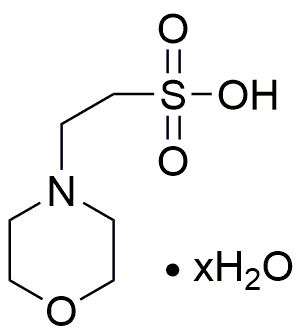MES hydrate is widely utilized in research focused on:
- Biological Buffers: Commonly used in cell culture and biochemical assays, MES hydrate helps maintain a stable pH, which is crucial for enzyme activity and cellular processes.
- Pharmaceutical Formulations: It serves as a buffering agent in drug formulations, ensuring that active ingredients remain stable and effective, particularly in injectable solutions.
- Electrophoresis: In molecular biology, MES hydrate is employed in gel electrophoresis to separate nucleic acids and proteins, providing clear and reproducible results.
- Environmental Testing: Used in the preparation of buffer solutions for environmental samples, it aids in the accurate measurement of pollutants and other substances in water quality assessments.
- Diagnostic Kits: MES hydrate is a key component in various diagnostic kits, enhancing the reliability of tests by stabilizing the pH of the reagents used.
General Information
Properties
Safety and Regulations
Applications
MES hydrate is widely utilized in research focused on:
- Biological Buffers: Commonly used in cell culture and biochemical assays, MES hydrate helps maintain a stable pH, which is crucial for enzyme activity and cellular processes.
- Pharmaceutical Formulations: It serves as a buffering agent in drug formulations, ensuring that active ingredients remain stable and effective, particularly in injectable solutions.
- Electrophoresis: In molecular biology, MES hydrate is employed in gel electrophoresis to separate nucleic acids and proteins, providing clear and reproducible results.
- Environmental Testing: Used in the preparation of buffer solutions for environmental samples, it aids in the accurate measurement of pollutants and other substances in water quality assessments.
- Diagnostic Kits: MES hydrate is a key component in various diagnostic kits, enhancing the reliability of tests by stabilizing the pH of the reagents used.
Documents
Safety Data Sheets (SDS)
The SDS provides comprehensive safety information on handling, storage, and disposal of the product.
Product Specification (PS)
The PS provides a comprehensive breakdown of the product’s properties, including chemical composition, physical state, purity, and storage requirements. It also details acceptable quality ranges and the product's intended applications.
Certificates of Analysis (COA)
Search for Certificates of Analysis (COA) by entering the products Lot Number. Lot and Batch Numbers can be found on a product’s label following the words ‘Lot’ or ‘Batch’.
*Catalog Number
*Lot Number
Certificates Of Origin (COO)
This COO confirms the country where the product was manufactured, and also details the materials and components used in it and whether it is derived from natural, synthetic, or other specific sources. This certificate may be required for customs, trade, and regulatory compliance.
*Catalog Number
*Lot Number
Safety Data Sheets (SDS)
The SDS provides comprehensive safety information on handling, storage, and disposal of the product.
DownloadProduct Specification (PS)
The PS provides a comprehensive breakdown of the product’s properties, including chemical composition, physical state, purity, and storage requirements. It also details acceptable quality ranges and the product's intended applications.
DownloadCertificates of Analysis (COA)
Search for Certificates of Analysis (COA) by entering the products Lot Number. Lot and Batch Numbers can be found on a product’s label following the words ‘Lot’ or ‘Batch’.
*Catalog Number
*Lot Number
Certificates Of Origin (COO)
This COO confirms the country where the product was manufactured, and also details the materials and components used in it and whether it is derived from natural, synthetic, or other specific sources. This certificate may be required for customs, trade, and regulatory compliance.


